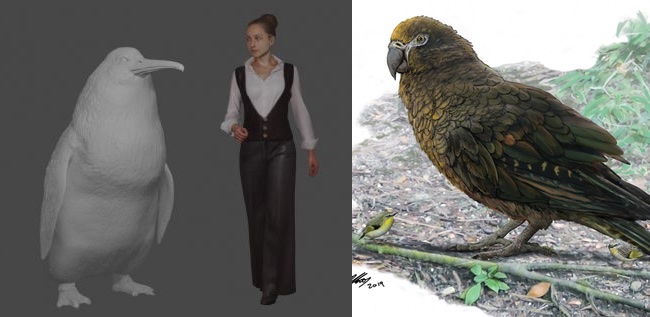- Paleontologists have found fossils of two extinct giant birds in New Zealand: an enormous penguin that would have been nearly as tall as an average adult human, and the largest parrot ever known to have existed.
- The new species of extinct giant penguin, formally named Crossvallia waiparensis, was described from leg bones found at the Waipara Greensand fossil site in the North Canterbury region in 2018.
- The extinct parrot, Heracles inexpectatus, was likely double the size of the previously largest known parrot species, the kakapo. The fossils of the parrot were first recovered from near St. Bathans in Central Otago in 2008.
Millions of years ago, giant birds roamed ancient New Zealand. There was the moa, an extinct flightless bird, thought to weigh up to 230 kilogram (510 pounds). Then there was the now-extinct Haast’s eagle, the largest eagle known to have ever lived, as well as several species of extinct giant penguins like the Kumimanu biceae.
Now, paleontologists have found fossils of two more extinct giant birds in New Zealand: an enormous penguin that would have been nearly as tall as an average adult human, and a parrot that would have been the largest known parrot to have ever existed. Researchers have described both species in two separate studies published this month.
Giant penguin
The new species of extinct giant penguin, formally named Crossvallia waiparensis, was described from leg bones found at the Waipara Greensand fossil site in the North Canterbury region in 2018. The penguin would have lived during the Paleocene epoch, or between 66 million and 56 million years ago, the researchers say in a new study.
From the length of the leg bones, they also conclude that the bird would have been 1.6 meters (5 feet, 3 inches) tall and would have weighed around 80 kilograms (176 pounds). For comparison, an emperor penguin, the tallest and heaviest of living penguin species, can reach heights of up to 1.3 meters (4 feet, 3 inches) and weigh up to 45 kilograms (99 pounds).

The closest relative of C. waiparensis is not another penguin from New Zealand, but a Paleocene penguin species C. unienwillia, described from a fossilized partial skeleton recovered from the Cross Valley in Antarctica in 2000, the researchers conclude.
“When the Crossvallia species were alive, New Zealand and Antarctica were very different from today — Antarctica was covered in forest and both had much warmer climates,” Paul Scofield, co-author of the study and senior curator at Canterbury Museum, said in a statement.
The Waipara Greensand site has been a gold mine for extinct penguin fossils. C. waiparensis is the fifth ancient penguin species to be described from fossils found there, and “there’s more to come, too,” said Gerald Mayr, co-author of the study and a paleontologist at the Senckenberg Natural History Museum in Frankfurt. “More fossils which we think represent new species are still awaiting description.”
World’s largest known parrot
Until recently, the kakapo, a flightless, critically endangered parrot in New Zealand, was the largest known parrot in the world. But the newly described species of extinct parrot Heracles inexpectatus, named after the hero of Greek mythology, was likely double its size, researchers say in another study published earlier this month.
H. inexpectatus would have weighed around 7 kilograms (15 pounds) and reached a height of about 1 meter (3 feet, 3 inches). It also likely had a massive beak that it may have used to “crack wide open anything it fancied … perhaps even other parrots,” Michael Archer, co-author of the study and paleontologist at the University of New South Wales in Australia, said in a statement.

The fossils of the giant parrot were first recovered from near St. Bathans in Central Otago, New Zealand, in 2008. For a long time, the researchers thought the bones belonged to an extinct species of eagle. But after further analysis, they concluded that the fossils were from a parrot species that had lived around 19 million years ago.
“New Zealand is well known for its giant birds,” said Trevor Worthy, lead author of the study and an associate professor at Flinders University in Adelaide. “Not only moa dominated avifaunas, but giant geese and adzebills shared the forest floor, while a giant eagle ruled the skies. But until now, no-one has ever found an extinct giant parrot — anywhere.”

Citations:
Mayr, G., De Pietri V. L., Love, L., Mannering, A., & Scofield, R. P. (2019) Leg bones of a new penguin species from the Waipara Greensand add to the diversity of very large-sized Sphenisciformes in the Paleocene of New Zealand. Alcheringa: An Australasian Journal of Palaeontology. doi: 10.1080/03115518.2019.1641619
Worthy, T. H., Hand, S. J., Archer, M., Scofield, R. P., & De Pietri, V. L. (2019). Evidence for a giant parrot from the Early Miocene of New Zealand. Biology letters, 15(8), 20190467. doi: 10.1098/rsbl.2019.0467
